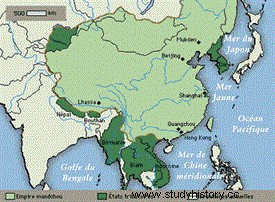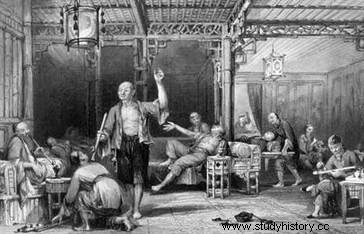 Throughout its history, the Chinese Empire had to face invaders from the north. The Ming Dynasty, which drove out the Mongols and ruled the mid-empire from 1368 to 1644, set out to build the 5,000 km Great Wall to defend its borders. In vain. In 1644, taking advantage of a civil war that was ravaging China, the Manchurians from the northern regions invaded the country and seized Beijing. Founders of the Qing Dynasty, they were the last rulers of Imperial China.
Throughout its history, the Chinese Empire had to face invaders from the north. The Ming Dynasty, which drove out the Mongols and ruled the mid-empire from 1368 to 1644, set out to build the 5,000 km Great Wall to defend its borders. In vain. In 1644, taking advantage of a civil war that was ravaging China, the Manchurians from the northern regions invaded the country and seized Beijing. Founders of the Qing Dynasty, they were the last rulers of Imperial China.
From the Ming to the Manchu emperors
In the 14th century, the Ming emperors ushered in a period of peace and governmental stability. The Chinese sphere of influence then reached an unprecedented scale, encompassing Vietnam and Burma in the south, Mongolia and Korea in the north. However, this empire remained folded in on itself. At the beginning of the 15th th century, at the head of an armada of junks, Admiral Zhang He skirted Southeast Asia and then landed in East Africa. But his death in 1433 put an end to China's maritime expansion. In 1557, the Portuguese founded a trading post in Macao, while the Dutch settled in Taiwan in 1622. However, relations between the Ming and European merchants remained very distant.
 Early 16th
th
century, the authority of the Ming dynasty began to crumble. The Liadong Peninsula, a Chinese enclave located northeast of the Great Wall, was protected by a wooden line of defense punctuated by gates topped by towers. It is not enough to stop the new rival power, the Manchus , a tribe from the north who entered China during a civil war. A Manchu leader, Dorgun, who reigned from 1628 to 1650, took control of Beijing in 1644, then ruled as regent on behalf of his nephew, who would become the first Qing emperor.
Early 16th
th
century, the authority of the Ming dynasty began to crumble. The Liadong Peninsula, a Chinese enclave located northeast of the Great Wall, was protected by a wooden line of defense punctuated by gates topped by towers. It is not enough to stop the new rival power, the Manchus , a tribe from the north who entered China during a civil war. A Manchu leader, Dorgun, who reigned from 1628 to 1650, took control of Beijing in 1644, then ruled as regent on behalf of his nephew, who would become the first Qing emperor.
Once their power was firmly established in China, the Qing set out to conquer Mongolia, Turkestan and Tibet. Thanks to this expansionist policy, the empire then achieved the largest territorial development in its history. Nepal, Bhutan, Laos, Burma and Annam were vassals of China, subject to paying regular tribes. To the north, Chinese expansion was halted by Russia's advance into Central and East Asia, but gained rights to the Amur region in return for a trade treaty.
Stability and demographic explosion
 After a five-year rebellion, crushed in 1680, Manchu-dominated China experienced a period of peace and prosperity which lasted more than a century under the leadership of the Qing. The ponytail or braid, a traditional Manchu attribute, was a way for the new dynasty to assert its authority by imposing it on its Chinese subjects (the Han). Marriages between Manchurians and Chinese were however prohibited, while the army and the administration remained sectors of activity accessible to the latter.
After a five-year rebellion, crushed in 1680, Manchu-dominated China experienced a period of peace and prosperity which lasted more than a century under the leadership of the Qing. The ponytail or braid, a traditional Manchu attribute, was a way for the new dynasty to assert its authority by imposing it on its Chinese subjects (the Han). Marriages between Manchurians and Chinese were however prohibited, while the army and the administration remained sectors of activity accessible to the latter.
While they boosted China's political and military affairs, the Manchus gave up trying to reform a cumbersome bureaucratic system in place for a millennium. The peasant revolts of the late Ming era had all but ended serfdom, but millions of sharecroppers barely managed to survive. Not having the means to follow the studies leading to access to the imperial bureaucracy, they had to bear most of the tax burden.
Between 1650 and 1800, the population of the Middle Kingdom grew from 100 to 300 million. The overcrowding of the central agricultural lands, in the Yangtze basin and in the south-east, forced many peasants to emigrate towards the western provinces, which were less populated. It is for China the beginning of a d demographic slippage uncontrolled, the middle empire not knowing the demographic revolution of Europe.
Difficult contacts with the outside world
While the Qing continued their expansionist policy in Asia, they were just as reluctant as their Ming predecessors to deal as equals with European traders . However, the fur trade with Russia was in full swing. 17 th Europe century fell in love with everything that came from China, especially porcelain, cotton, silk and tea. European merchants having no product to offer in exchange, they paid for exported objects with money taken from the new world, which was very expensive. Canton in the south was declared the only port accessible to European traders.
 Reached as far as China in the XVII
th
century, the Jesuits were tolerated there for their knowledge of physics and astronomy, even if they paled in comparison to the scientists of the Middle Kingdom. Conversions, on the other hand, remained rare. Subsequently, Christianity was simply banned because it was considered incompatible with the ancestor worship practiced by the Chinese.
Reached as far as China in the XVII
th
century, the Jesuits were tolerated there for their knowledge of physics and astronomy, even if they paled in comparison to the scientists of the Middle Kingdom. Conversions, on the other hand, remained rare. Subsequently, Christianity was simply banned because it was considered incompatible with the ancestor worship practiced by the Chinese.
The reign of the Qianlong Emperor
Emperor Qianlong , who reigned from 1735 to 1796, enjoyed the longest reign in Chinese history. Scholar and protector of the arts, he considered his immense empire to be the only civilized country in the world. He received with disdain a delegation of British traders led by Lord McCartney. Arguing that they had refused to prostrate themselves before the sovereign, in accordance with tradition, he put an end to commercial relations with the English. However, the British mission had been able to observe the Chinese methods of making tea and silk. They were passed on to the British East India Company, which quickly organized parallel production circuits.
At the end of Qianlong's reign, China was already showing clear signs of decline. The administration was plagued by corruption, while tax increases sparked new waves of peasant revolts. No one could ignore the superiority of European technologies any longer, but the Qinq remained too conservative to consider any modernization.
The inexorable agony of the Chinese Empire
 During the 19th century, the fragile Qing dynasty maintained an isolationist policy towards the West , but could not prevent European merchants from expanding their trading interests. Great Britain, whose main import to China is opium grown in India, takes possession of Hong Kong, which becomes a commercial colony, and wins the opening of five ports under treaties intended for foreign trade, following the two Opium Wars (1839-1842,1856-1860). In addition, China is losing control over Central and Southeast Asia and Russia is seizing territories in Siberia, including the province of Amur.
During the 19th century, the fragile Qing dynasty maintained an isolationist policy towards the West , but could not prevent European merchants from expanding their trading interests. Great Britain, whose main import to China is opium grown in India, takes possession of Hong Kong, which becomes a commercial colony, and wins the opening of five ports under treaties intended for foreign trade, following the two Opium Wars (1839-1842,1856-1860). In addition, China is losing control over Central and Southeast Asia and Russia is seizing territories in Siberia, including the province of Amur.
On the domestic front, the situation is hardly any better. The miserable living conditions of the vast majority of the population lead to frequent uprisings. Thus the Taiping revolt (1850-1864) threatened the survival of the Qing; the repression claimed an appalling number of victims. Dissent is manifested in particular by a violent rejection of foreigners. In 1900-1901, the Boxer rebels (so named because members of the secret society of the “League of Justice and Concord Fists”) attacked foreign embassies and commercial legations, murdering Chinese Christians. The West sends troops to put down the revolt; several leaders are beheaded in the public square. China must then pay huge financial compensation.
At the end of the 19th th century China was on the edge of the abyss, sinking into anarchy. The West took advantage of this to impose commercial treaties and humiliating port concessions on it, accelerating the decomposition of the Middle Kingdom. In 1912 the last Manchu emperor, Pu Yi, was deposed by revolutionaries who proclaimed the republic.
Bibliography
- The Imperial China of Dionysius Lombard. PUF, 2001.
- China in the Eighteenth Century:The Apogee of the Sino-Manchu Qing Empire, by Damien Chaussende. The Beautiful Letters, 2013.
